Reducing Surface Wetting Proportion of Soils Irrigated by Subsurface Drip Irrigation Can Mitigate Soil N2O Emission
Abstract
1. Introduction
2. Materials and Methods
2.1. Soil Characteristics
2.2. Experimental Design
2.3. Irrigation Management and Soil Moisture Measurement
2.4. Sampling and Analysis of N2O
2.5. Statistical Analysis
3. Results
3.1. Soil Moisture Distribution
3.2. N2O Emission
3.3. Reduction in N2O Emissions of SDI Soils
3.4. Relationship between N2O Emissions and Soil WFPS
4. Discussion
5. Conclusions
Author Contributions
Funding
Acknowledgments
Conflicts of Interest
References
- Pachauri, R.K.; Reisinger, A. Contribution of Working Groups I, II and III to the Fourth Assessment Report of the Intergovernmental Panel on Climate Change; IPCC: Geneva, Switzerland, 2007. [Google Scholar]
- IPCC. Contribution of Work-ing Group I to the Fifth Assessment Report of the Intergovernmental Panel on Climate Change. In Climate Change 2013: The Physical Science Basis; Cambridge University Press: Cambridge, UK; New York, NY, USA, 2013. [Google Scholar]
- Hou, H.J.; Yang, S.H.; Wang, F.T.; Li, D.; Xu, J.Z. Controlled irrigation mitigates the annual integrative global warming potential of methane and nitrous oxide from the rice–winter wheat rotation systems in Southeast China. Ecol. Eng. 2016, 86, 239–246. [Google Scholar] [CrossRef]
- Arevalo-Martinez, D.L.; Kock, A.; Löscher, C.R.; Schmitz, R.A.; Bange, H.W. Massive nitrous oxide emissions from the tropical South Pacific Ocean. Nat. Geosci. 2015, 8, 530–532. [Google Scholar] [CrossRef]
- Reay, D.S.; Davidson, E.A.; Smith, K.A. Global agriculture and nitrous oxide emissions. Nat. Clim. Change. 2012, 2, 410–414. [Google Scholar] [CrossRef]
- Schaufler, G.; Kitzler, B.; Schindlbacher, A.; Skiba, U.; Sutton, M.A.; Zechmeister-Boltenstern, S. Greenhouse gas emissions from European soils under different land use: effects of soil moisture and temperature. Eur. J. Soil Sci. 2010, 61, 683–696. [Google Scholar] [CrossRef]
- Hadi, A.; Inubushi, K.; Yagi, K. Effect of water management on greenhouse gas emissions and microbial properties of paddy soils in Japan and Indonesia. Paddy. Water. Environ. 2010, 8, 319–324. [Google Scholar] [CrossRef]
- Hou, H.J.; Chen, H.; Cai, H.J.; Yang, F.; Li, D.; Wang, F.T. N2O and CO2 emissions from Lou soils of greenhouse tomato fields under aerated irrigation. Atmos. Environ. 2016, 132, 69–76. [Google Scholar] [CrossRef]
- Jauhiainen, J.; Silvennoinen, H.; Hämäläinen, R.; Kusin, K. Nitrous oxide fluxes from tropical peat with different disturbance history and management. Biogeosciences. 2011, 8, 5423–5450. [Google Scholar] [CrossRef]
- Ruser, R.; Flessa, H.; Russow, R. Emission of N2O, N2 and CO2 from soilfertilized with nitrate: Effect of compaction, soil moisture and rewetting. Soil. Biol. Biochem. 2006, 38, 263–274. [Google Scholar] [CrossRef]
- Sánchez-Martín, L.; Arce, A.; Benito, A. Influence of drip and furrow irrigation systems on nitrogen oxide emissions from a horticultural crop. Soil. Biol. Biochem. 2008, 40, 1698–1706. [Google Scholar] [CrossRef]
- Qiu, Z.J.; Li, J.S.; Zhao, W.X. Effects of lateral depth and irrigation level on nitrate and Escherichia coli leaching in the North China Plain for subsurface drip irrigation applying sewage effluent. Irrigation. Sci. 2017, 35, 469–482. [Google Scholar] [CrossRef]
- Kallenbach, C.M.; Rolston, D.E.; Horwath, W.R. Cover cropping affects soil N2O and CO2 emissions differently depending on type of irrigation. Agr. Ecosyst. Environ. 2010, 137, 251–260. [Google Scholar] [CrossRef]
- Wang, G.S.; Liang, Y.P.; Zhang, Q.; Jha, S.K.; Gao, Y.; Shen, X.J.; Sun, J.S.; Duan, A.W. Mitigated CH4 and N2O emissions and improved irrigation water use efficiency in winter wheat field with surface drip irrigation in the North China Plain. Agr. Water. Manage. 2016, 163, 403–407. [Google Scholar] [CrossRef]
- Kouznetsov, M.Y.; Packov, P.; Gillerman, L.; Gantzer, C.; Oron, G. Microbial transport in soil caused by surface and subsurface drip irrigation with treated wastewater. Int. Agrophys. 2004, 18, 239–247. [Google Scholar]
- Badr, A.E.; Abuarab, M.E. Soil moisture distribution patterns under surface and subsurface drip irrigation systems in sandy soil using neutron scattering technique. Irrigation. Sci. 2013, 31, 317–332. [Google Scholar] [CrossRef]
- Sánchez-Martín, L.; Meijide, A.; Garcia-Torres, L. Combination of drip irrigation and organic fertilizer for mitigating emissions of nitrogen oxides in semiarid climate. Agr. Ecosyst. Environ. 2010, 137, 99–107. [Google Scholar] [CrossRef]
- Kennedy, T.L.; Suddick, E.C.; Six, J. Reduced nitrous oxide emissions and increased yields in California tomato cropping systems under drip irrigation and fertigation. Agr. Ecosyst. Environ. 2013, 170, 16–27. [Google Scholar] [CrossRef]
- Wei, Q.; Xu, J.Z.; Yang, S.H.; Qi, Z.M.; Wang, Y.H.; Liao, L.X. Partial wetting irrigation resulted in non-uniformly low nitrous oxide emissions from soil. Atmos. Environ. 2017, 161, 200–209. [Google Scholar] [CrossRef]
- Kazumba, S.; Gillerman, L.; Demalach, Y. Sustainable domestic effluent reuse via subsurface drip irrigation (SDI): alfalfa as a perennial model crop. Water. Sci. Technol. 2010, 61, 625–632. [Google Scholar] [CrossRef]
- Wang, R.S.; Kang, Y.H.; Wan, S.Q.; Hu, W.; Liu, S.P.; Liu, S.H. Salt distribution and the growth of cotton under different drip irrigation regimes in a saline area. Agr. Water. Manage. 2011, 100, 58–69. [Google Scholar] [CrossRef]
- Beare, M.H.; Gregorich, E.G.; St-Georges, P. Compaction effects on CO2 and N2O production during drying and rewetting of soil. Soil. Biol. Biochem. 2009, 41, 611–621. [Google Scholar] [CrossRef]
- Manalil, S.; Riethmuller, G.; Flower, K. Rapid emission of nitrous oxide from fallow over summer following wetting in a Mediterranean-type environment. Soil. Till. Rese. 2014, 143, 130–136. [Google Scholar] [CrossRef]
- Li, X.L.; Ma, J.; Xu, H.; Cao, J.L.; Cai, Z.C.; Yag, K. Effect of Water Management on Seasonal Variations of Methane and Nitrous Oxide Emissions During Rice Growing Period (Chinese with English abstract). J. Agr. Environ. Sci. 2008, 27, 535–541. [Google Scholar]
- Lin, S.; Iqbal, J.; Hu, R.G.; Ruan, L.L.; Wu, J.S.; Zhao, J.S.; Wang, P.J. Differences in nitrous oxide fluxes from red soil under different land uses in mid-subtropical China. Agr. Ecosyst. Environ. 2012, 146, 168–178. [Google Scholar] [CrossRef]
- Maris, S.C.; Lloveras, J.; Vallejo, A.; Teira-Esmateges, M.R. Effect of Stover Management and Nitrogen Fertilization on N2O and CO2 Emissions from Irrigated Maize in a High Nitrate Mediterranean Soil. Water. Air. Soil Poll. 2018, 229, 11. [Google Scholar] [CrossRef]
- Abalos, D.; Sanchez-Martin, L.; Garcia-Torres, L.; van Groenigen, J.W.; Vallejo, A. Management of irrigation frequency and nitrogen fertilization to mitigate GHG and NO emissions from drip-fertigated crops. Sci. Total Environ. 2014, 490, 880–888. [Google Scholar] [CrossRef] [PubMed]
- Khalil, M.I.; Baggs, E.M. CH4 oxidation and N2O emissions at varied soil water-filled pore spaces and headspace CH4 concentrations. Soil. Biol. Biochem. 2005, 37, 1785–1794. [Google Scholar] [CrossRef]
- Sey, B.; Manceur, A.; Whalen, J.K.; Gregorich, E.G.; Rochette, P. Small-scale heterogeneity in carbon dioxide, nitrous oxide and methane production from aggregates of a cultivated sandy-loam soil. Soil. Biol. Biochem. 2008, 40, 2468–2473. [Google Scholar] [CrossRef]
- Weslien, P.; Rütting, T.; Kasimir-Klemedtsson, Å. Carrot cropping on organic soil is a hotspot for nitrous oxide emissions. Nutr. Cycl. Agroecosys. 2012, 94, 249–253. [Google Scholar] [CrossRef]
- Yan, J.H.; Zhang, W.; Wang, K.Y.; Qin, F.; Wang, W.T.; Dai, H.T.; Li, P.X. Responses of CO2, N2O and CH4 fluxes between atmosphere and forest soil to changes in multiple environmental conditions. Global. Change. Biol. 2014, 20, 300–312. [Google Scholar] [CrossRef] [PubMed]
- Yamamoto, A.; Akiyama, H.; Naokawa, T.; Yagi, K. Effect of lime-nitrogen application on NO emission from an Andosol vegetable field. Soil. Sci. Plant. Nutr. 2012, 58, 245–254. [Google Scholar] [CrossRef]
- Pfab, H.; Palmer, I.; Buegger, F. Influence of a nitrification inhibitor and of placed N-fertilization on N2O fluxes from a vegetable cropped loamy soil. Agr. Ecosyst. Environ. 2012, 150, 91–101. [Google Scholar] [CrossRef]
- Shi, P.Z.; Ma, J.Z. Theory and Practice of Water-saving Irrigation in Arid Areas: Comprehensive Water-saving Scientific Experiment of Agricultural Irrigation in Wuwei City; Lanzhou University Press: Lanzhou, China, 2004. [Google Scholar]
- Maris, S.C.; Teira-Esmatges, M.R.; Arbonésb, A.; Rufat, J. Effect of irrigation, nitrogen application, and a nitrification inhibitor on nitrous oxide, carbon dioxide and methane emissions from an olive (Olea europaea L.) orchard. Sci. Total. Environ. 2015, 538, 966–978. [Google Scholar] [CrossRef] [PubMed]
- Bronson, K.F.; Hunsaker, D.J.; Williams, C.F.; Thorp, K.R.; Rockholt, S.M.; Del Grosso, S.J.; Venterea, R.T.; Barnes, E.M. Nitrogen Management Affects Nitrous Oxide Emissions under Varying Cotton Irrigation Systems in the Desert Southwest, USA. J. Environ. Qual. 2018, 47, 70–78. [Google Scholar] [CrossRef] [PubMed]

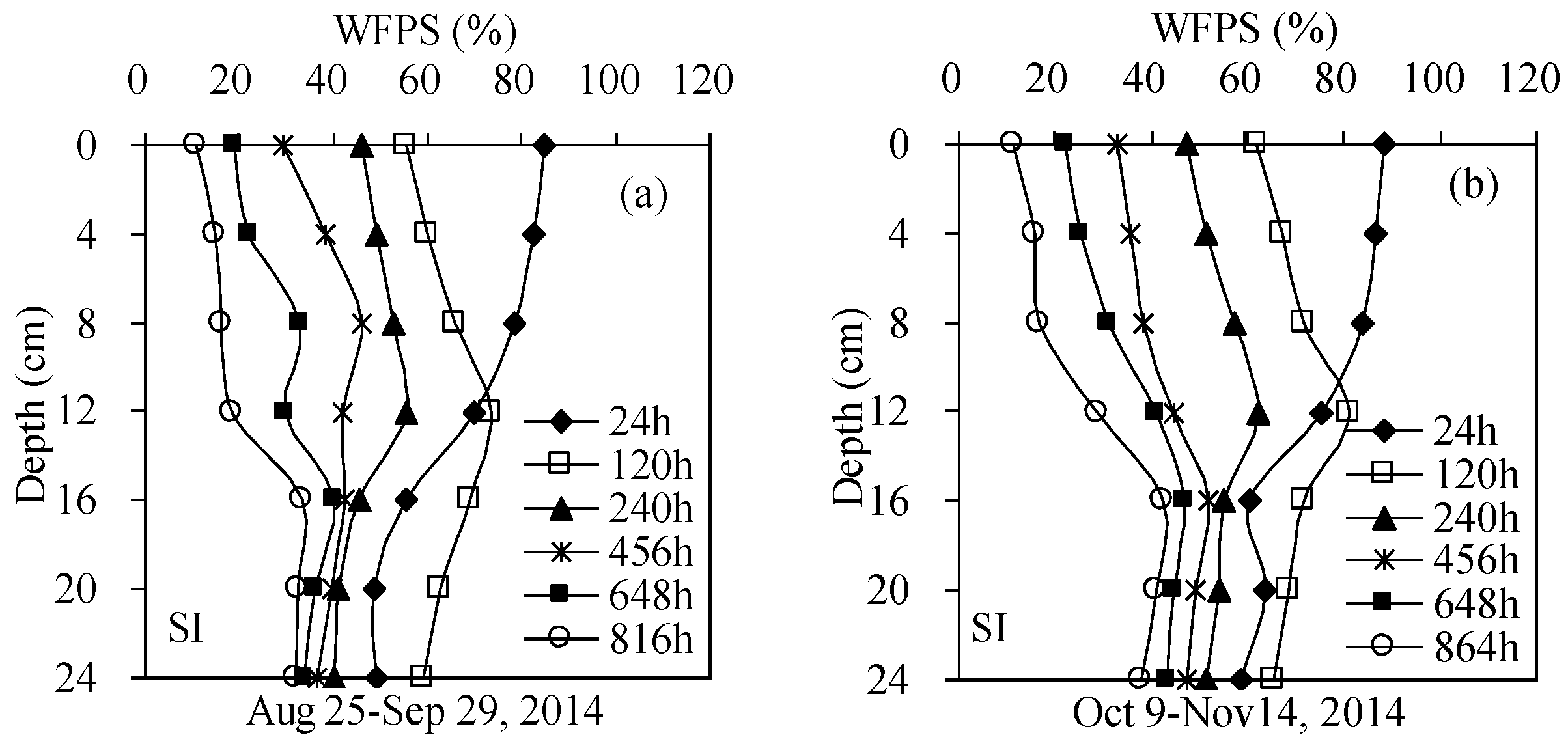
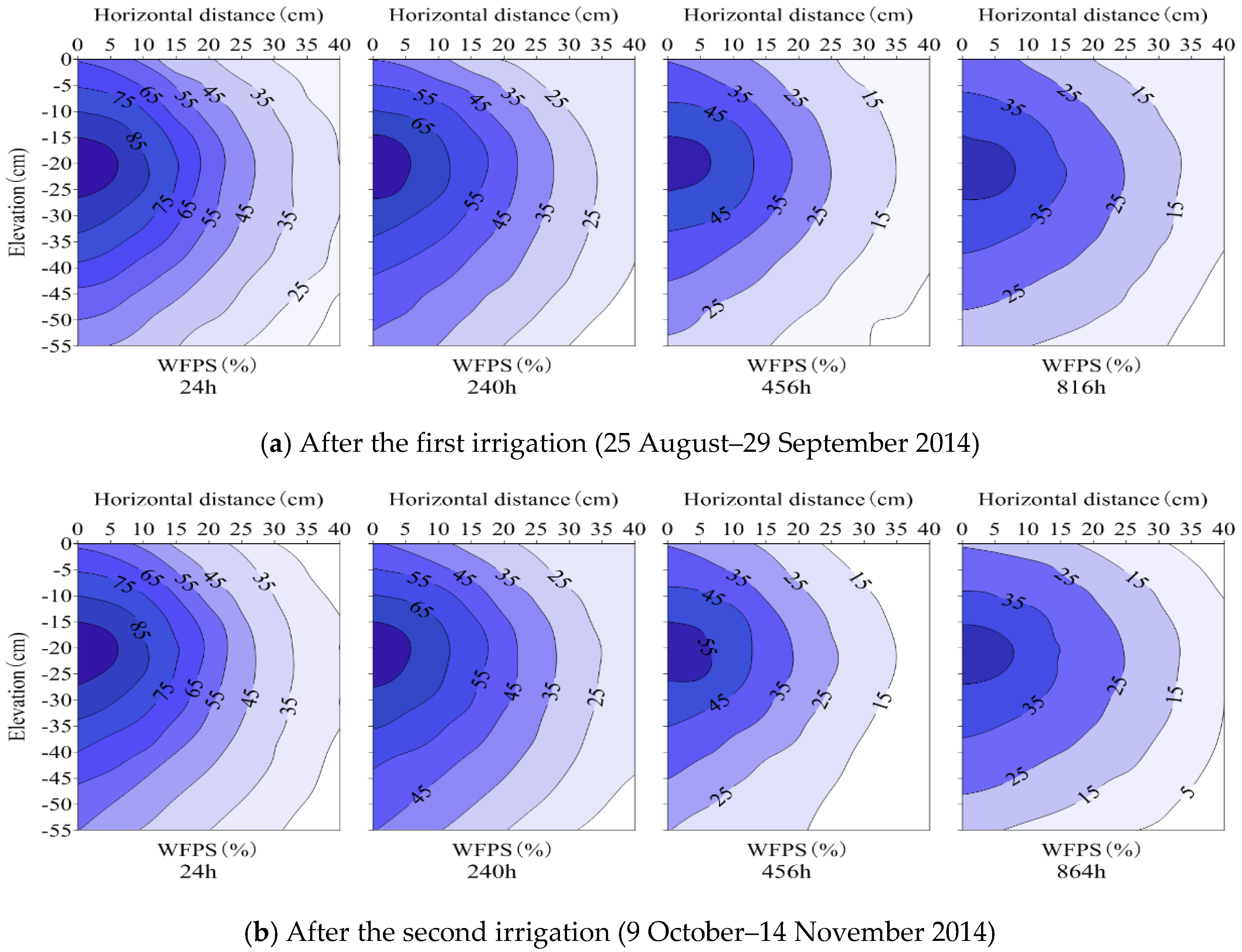
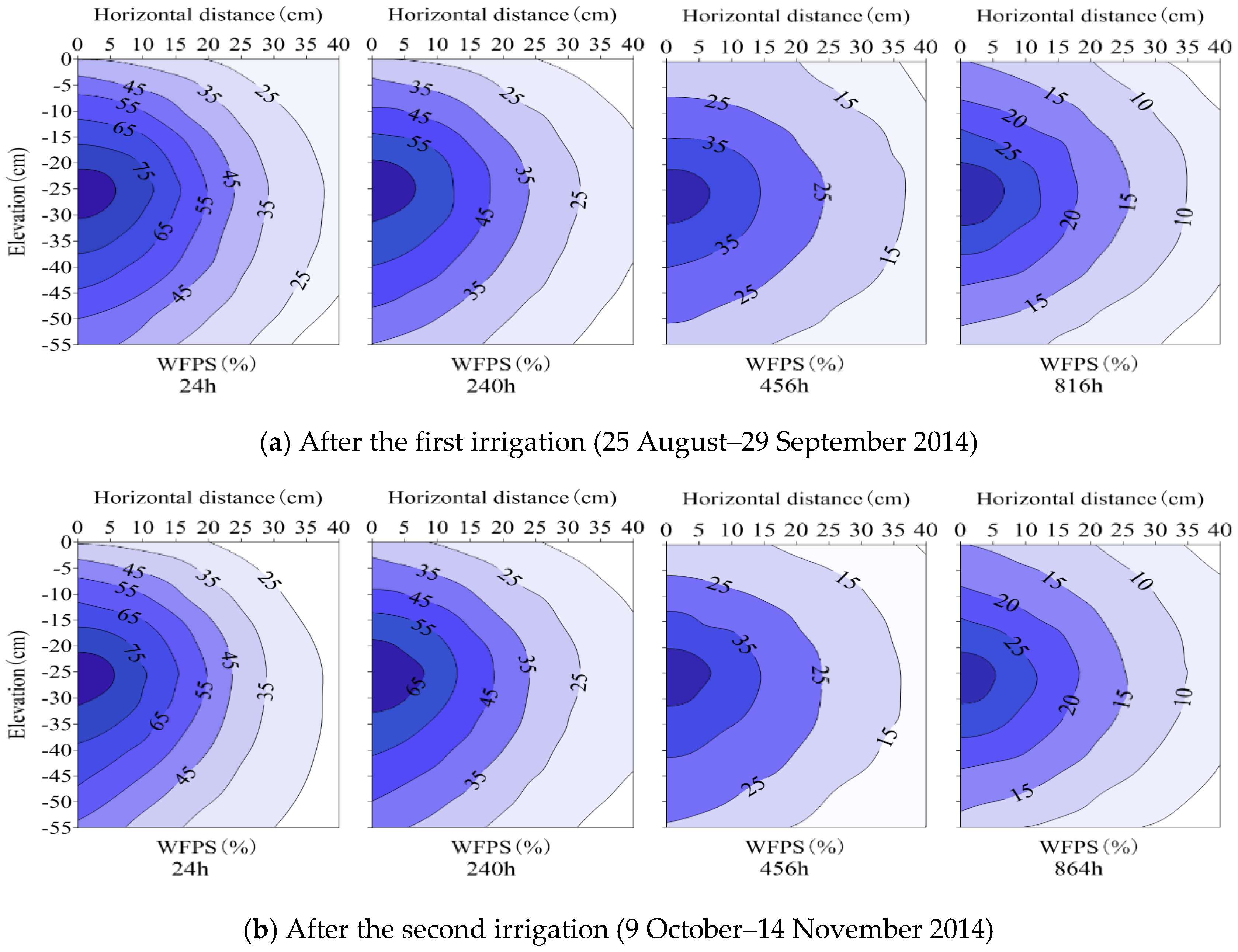
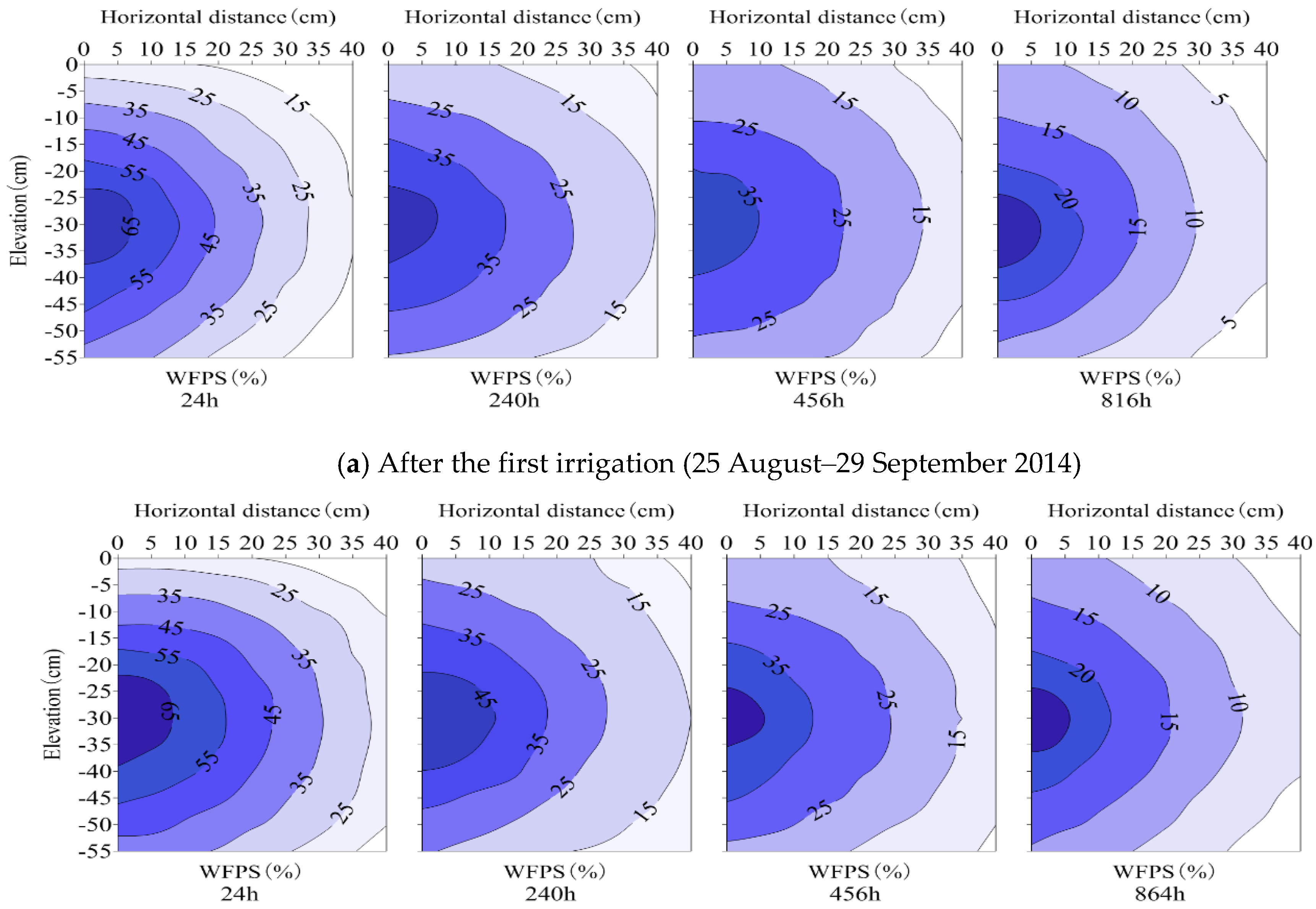
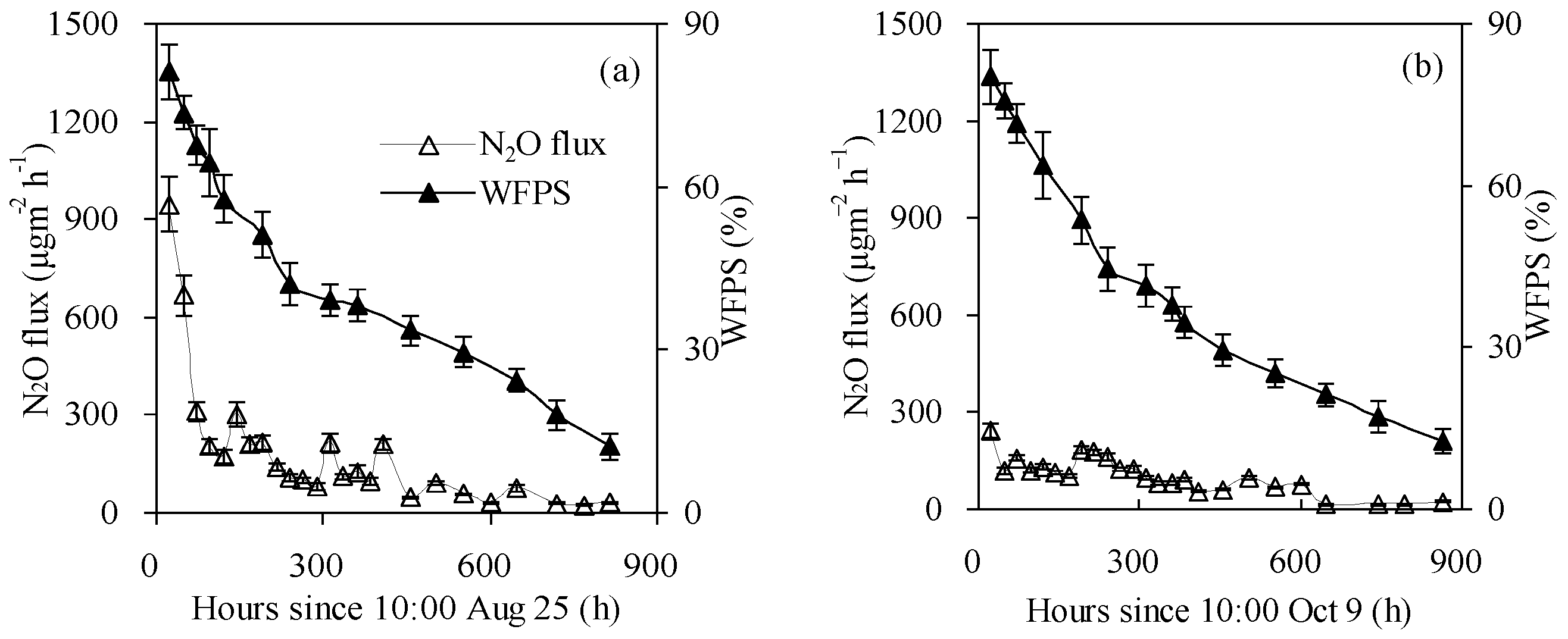
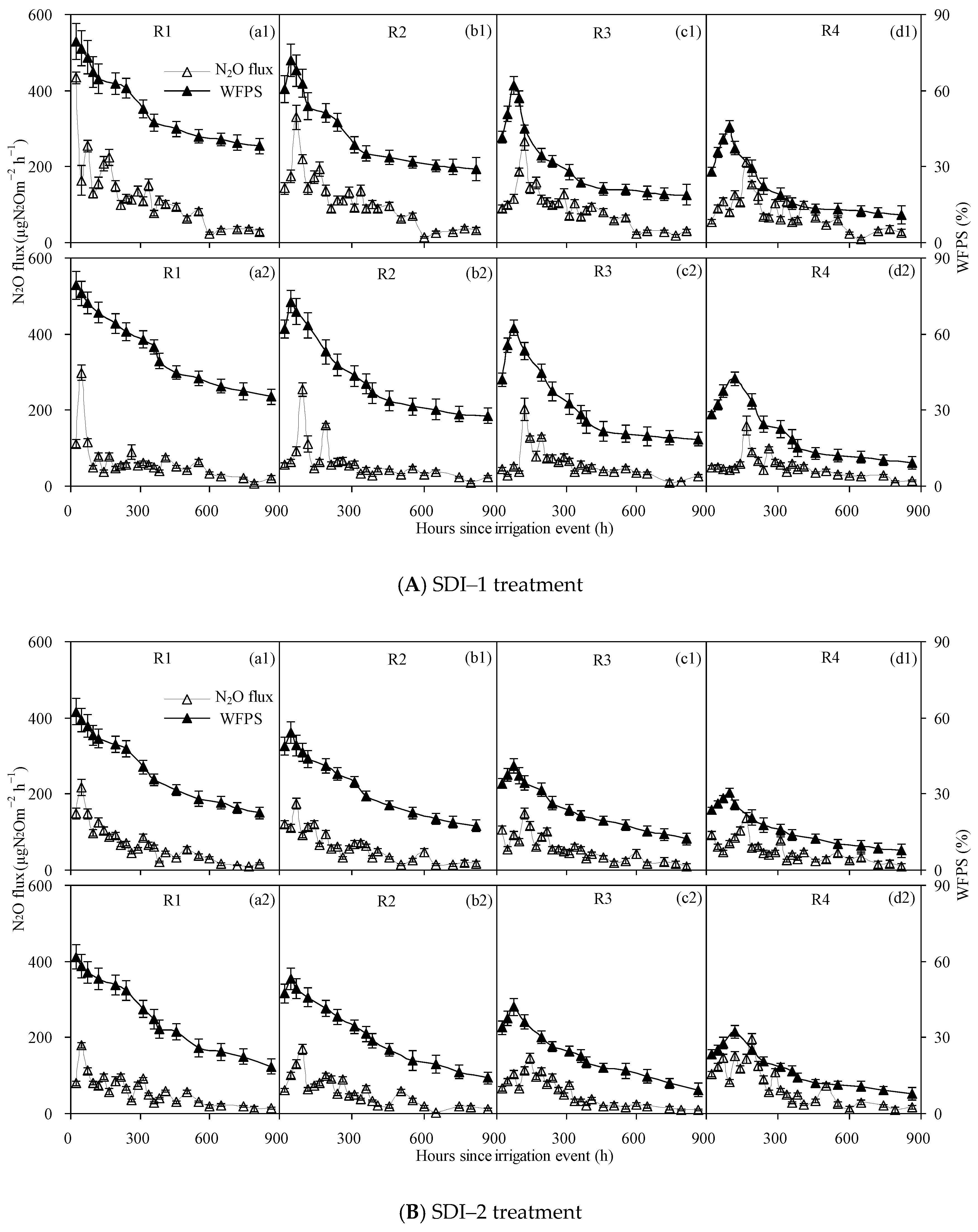

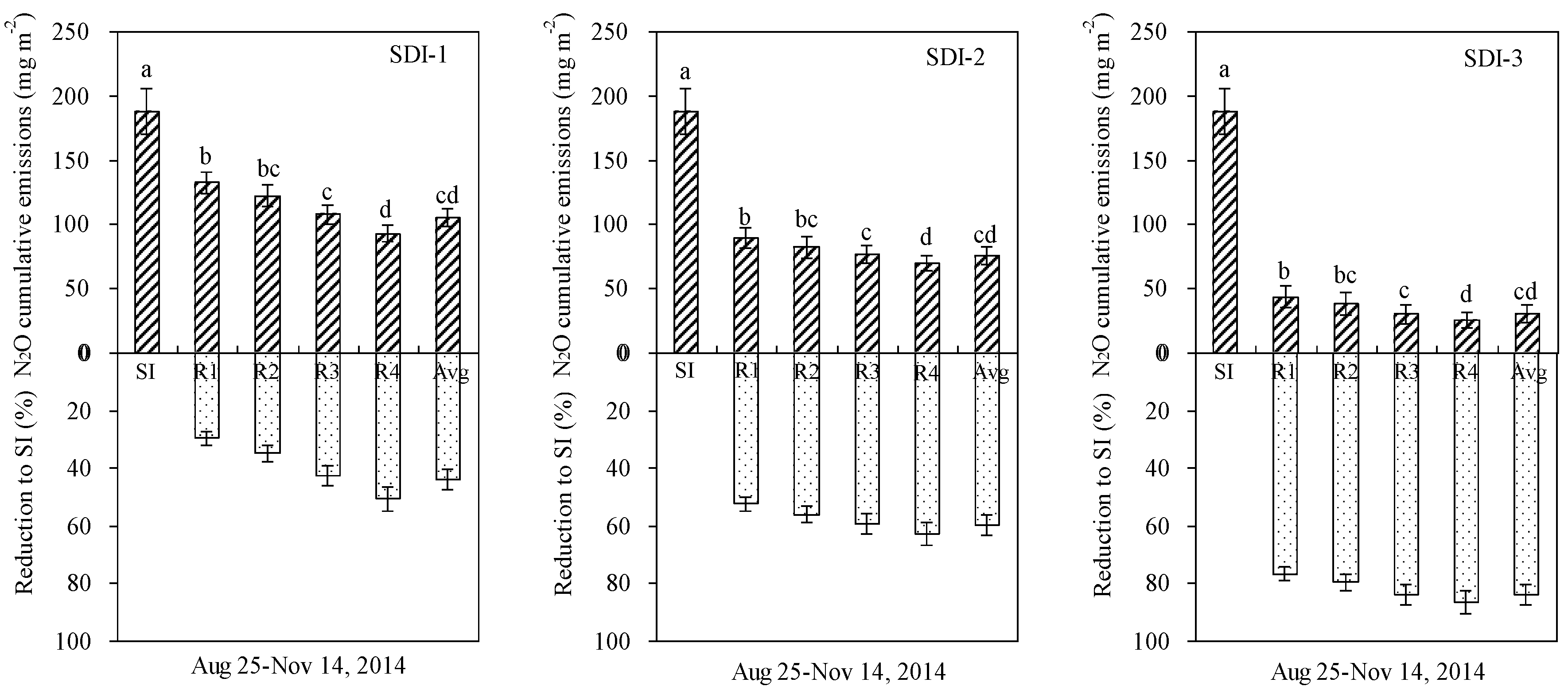
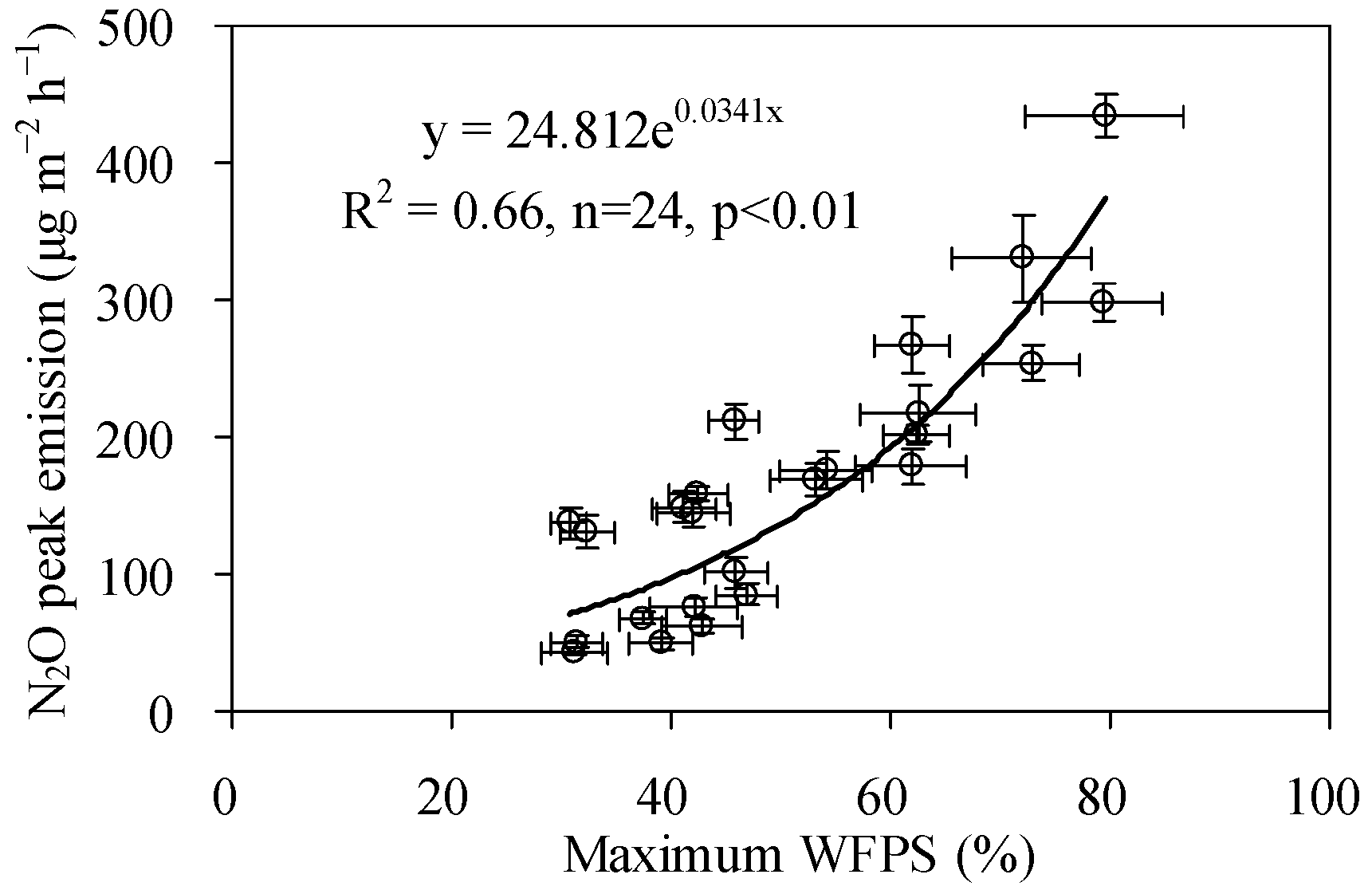
| Treatment (n = 3) | Sub-Region | Reduction in N2O Emission of SDI Treatment (%) | |||
|---|---|---|---|---|---|
| Observation Period | P/W | ||||
| Pulse Period | Post-Pulse Period | Whole Observation Period | |||
| SDI–1 | R1 (1–9 cm) | 40.2 | 12.5 | 29.4 | 136.6 |
| R2 (10–18 cm) | 43.9 | 20.5 | 34.8 | 126.1 | |
| R3 (19–27 cm) | 53.5 | 25.0 | 42.5 | 126.1 | |
| R4 (28–36 cm) | 63.0 | 31.0 | 50.6 | 124.6 | |
| Avg | 55.2 | 26.2 | 43.8 | 125.9 | |
| SDI–2 | R1 (1–9 cm) | 58.6 | 42.4 | 52.3 | 112.0 |
| R2 (10–18 cm) | 60.3 | 49.6 | 56.1 | 107.4 | |
| R3 (19–27 cm) | 63.1 | 52.9 | 59.1 | 106.7 | |
| R4 (28–36 cm) | 67.7 | 55.0 | 62.8 | 107.8 | |
| Avg | 64.4 | 52.7 | 59.8 | 107.7 | |
| SDI–3 | R1 (1–9 cm) | 77.6 | 75.4 | 76.7 | 101.2 |
| R2 (10–18 cm) | 82.3 | 76.7 | 79.6 | 103.4 | |
| R3 (19–27 cm) | 85.4 | 81.4 | 83.8 | 101.8 | |
| R4 (28–36 cm) | 87.6 | 84.6 | 86.4 | 101.3 | |
| Avg | 85.4 | 81.4 | 83.7 | 102.0 | |
| Treatment (n = 3) | Sub-Region | Region Area (cm2) | Cumulative N2O Emission (mg) | Reduction in N2O Emission (mg) | Contribution to Total N2O Reduction (%) |
|---|---|---|---|---|---|
| SDI–1 | R1 | 125.6 | 1.7 | 0.7 | 4.6 |
| R2 | 351.7 | 4.3 | 2.3 | 15.1 | |
| R3 | 577.8 | 6.2 | 4.6 | 30.2 | |
| R4 | 803.8 | 7.5 | 7.6 | 50.1 | |
| Total | 1858.9 | 19.7 | 15.2 | 100.0 | |
| SDI–2 | R1 | 125.6 | 1.1 | 1.2 | 5.9 |
| R2 | 351.7 | 2.9 | 3.7 | 17.8 | |
| R3 | 577.8 | 4.4 | 6.4 | 30.8 | |
| R4 | 803.8 | 5.6 | 9.5 | 45.5 | |
| Total | 1858.9 | 14.1 | 20.8 | 100.0 | |
| SDI–3 | R1 | 125.6 | 0.5 | 1.8 | 6.2 |
| R2 | 351.7 | 1.3 | 5.3 | 18.0 | |
| R3 | 577.8 | 1.8 | 9.1 | 31.1 | |
| R4 | 803.8 | 2.1 | 13.0 | 44.7 | |
| Total | 1858.9 | 5.7 | 29.2 | 100.0 |
| Treatment | Sub-Region | Relation | Coefficient of Determination (R2) | Significance |
|---|---|---|---|---|
| SDI–1 | R1 (1–9 cm) | y = 6.265e4.451x | 0.671 | p < 0.05 |
| R2 (10–18 cm) | y = 14.622e3.443x | 0.534 | p < 0.05 | |
| R3 (19–27 cm) | y = 23.651e2.815x | 0.334 | p < 0.05 | |
| R4 (28–36 cm) | y = 21.963e3.464x | 0.423 | p < 0.05 | |
| Overall | y = 23.010e2.554x | 0.433 | p < 0.05 | |
| SDI–2 | R1 (1–9 cm) | y = 5.551e5.517x | 0.864 | p < 0.05 |
| R2 (10–18 cm) | y = 4.728e6.573x | 0.733 | p < 0.05 | |
| R3 (19–27 cm) | y = 6.215e7.618x | 0.807 | p < 0.05 | |
| R4 (28–36 cm) | y = 9.283e8.134x | 0.708 | p < 0.05 | |
| Overall | y = 11.985e4.462x | 0.561 | p < 0.05 | |
| SDI–3 | R1 (1–9 cm) | y = 2.639e7.221x | 0.723 | p < 0.05 |
| R2 (10–18 cm) | y = 3.763e6.328x | 0.557 | p < 0.05 | |
| R3 (19–27 cm) | y = 3.126e7.486x | 0.465 | p < 0.05 | |
| R4 (28–36 cm) | y = 3.107e8.563x | 0.494 | p < 0.05 | |
| Overall | y = 3.799e6.493x | 0.556 | p < 0.05 |
© 2018 by the authors. Licensee MDPI, Basel, Switzerland. This article is an open access article distributed under the terms and conditions of the Creative Commons Attribution (CC BY) license (http://creativecommons.org/licenses/by/4.0/).
Share and Cite
Wei, Q.; Xu, J.; Li, Y.; Liao, L.; Liu, B.; Jin, G.; Hameed, F. Reducing Surface Wetting Proportion of Soils Irrigated by Subsurface Drip Irrigation Can Mitigate Soil N2O Emission. Int. J. Environ. Res. Public Health 2018, 15, 2747. https://doi.org/10.3390/ijerph15122747
Wei Q, Xu J, Li Y, Liao L, Liu B, Jin G, Hameed F. Reducing Surface Wetting Proportion of Soils Irrigated by Subsurface Drip Irrigation Can Mitigate Soil N2O Emission. International Journal of Environmental Research and Public Health. 2018; 15(12):2747. https://doi.org/10.3390/ijerph15122747
Chicago/Turabian StyleWei, Qi, Junzeng Xu, Yawei Li, Linxian Liao, Boyi Liu, Guangqiu Jin, and Fazli Hameed. 2018. "Reducing Surface Wetting Proportion of Soils Irrigated by Subsurface Drip Irrigation Can Mitigate Soil N2O Emission" International Journal of Environmental Research and Public Health 15, no. 12: 2747. https://doi.org/10.3390/ijerph15122747
APA StyleWei, Q., Xu, J., Li, Y., Liao, L., Liu, B., Jin, G., & Hameed, F. (2018). Reducing Surface Wetting Proportion of Soils Irrigated by Subsurface Drip Irrigation Can Mitigate Soil N2O Emission. International Journal of Environmental Research and Public Health, 15(12), 2747. https://doi.org/10.3390/ijerph15122747






